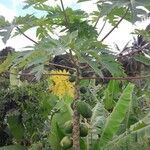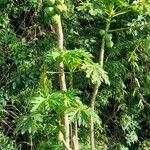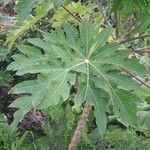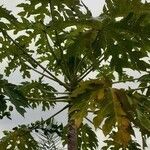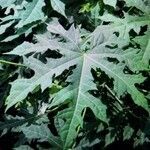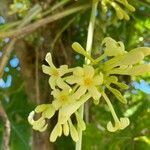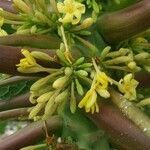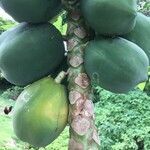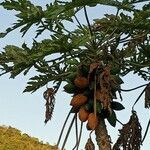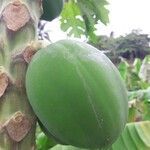| Therapeutic use
|
Dental caries (bark), Hemolysis (bark), Toothache (bark), Urination disorders (bark), Antipyretics (flower), Jaundice (flower), Menstruation-inducing agents (flower), Breast Treatment (fruit), Abdominal pain (fruit), Abortifacient agents (fruit), Analgesics (fruit), Anorexia (fruit), Anthelmintics (fruit), Anti-bacterial agents (fruit), Anticoagulants (fruit), Antifungal agents (fruit), Anti-inflammatory agents (fruit), Aphrodisiacs (fruit), Appetite stimulants (fruit), Asthma (fruit), Bites and stings (fruit), Bronchitis (fruit), Constipation (fruit), Contraceptive agents (fruit), Cough (fruit), Demulcents (fruit), Diabetes mellitus (fruit), Diarrhea (fruit), Diet, food, and nutrition (fruit), Digestive system diseases (fruit), Diuretics (fruit), Dysentery (fruit), Dyspepsia (fruit), Expectorants (fruit), Flatulence (fruit), Galactogogues (fruit), Gout (fruit), Helminthiasis (fruit), Hematologic diseases (fruit), Hemoptysis (fruit), Hemorrhage (fruit), Hemorrhoids (fruit), Hemostatics (fruit), Hepatomegaly (fruit), Hypnotics and sedatives (fruit), Hypolipidemic agents (fruit), Inflammation (fruit), Intestinal diseases, parasitic (fruit), Jaundice (fruit), Lactation disorders (fruit), Laxatives (fruit), Leukorrhea (fruit), Liver diseases (fruit), Malaria (fruit), Freckles (fruit), Menstruation-inducing agents (fruit), Oxytocics (fruit), Psoriasis (fruit), General tonic for rejuvenation (fruit), Skin care (fruit), Skin diseases (fruit), Splenomegaly (fruit), Stomach diseases (fruit), Toothache (fruit), Ulcer (fruit), Urinary calculi (fruit), Injury of urinary tract (fruit), Urinary tract infections (fruit), Weight loss (fruit), Abortifacient agents (leaf), Anthelmintics (leaf), Anti-bacterial agents (leaf), Anticonvulsants (leaf), Antifungal agents (leaf), Antipyretics (leaf), Asthma (leaf), Beriberi (leaf), Cathartics (leaf), Cholinergic antagonists (leaf), Colic (leaf), Constipation (leaf), Dracunculiasis (leaf), Dyspepsia (leaf), Fever (leaf), Fractures, bone (leaf), Gonorrhea (leaf), Heart diseases (leaf), Hypnotics and sedatives (leaf), Jaundice (leaf), Seizures (leaf), Urination disorders (leaf), Wound healing (leaf), Wounds and injuries (leaf), Abdominal pain (plant exudate), Abortifacient agents (plant exudate), Amenorrhea (plant exudate), Analgesics (plant exudate), Anthelmintics (plant exudate), Anti-bacterial agents (plant exudate), Antidiuretic agents (plant exudate), Antifungal agents (plant exudate), Anti-inflammatory agents (plant exudate), Antineoplastic agents (plant exudate), Antipruritics (plant exudate), Antipyretics (plant exudate), Ascariasis (plant exudate), Asthenia (plant exudate), Bites and stings (plant exudate), Carbuncle (plant exudate), Dental caries (plant exudate), Digestive system diseases (plant exudate), Dysmenorrhea (plant exudate), Dyspepsia (plant exudate), Eczema (plant exudate), Fever (plant exudate), Galactogogues (plant exudate), Gastritis (plant exudate), Gingivitis (plant exudate), Headache (plant exudate), Hemorrhage (plant exudate), Hypohidrosis (plant exudate), Inflammation (plant exudate), Counterirritant (plant exudate), Jaundice (plant exudate), Kidney calculi (plant exudate), Lactation disorders (plant exudate), Laxatives (plant exudate), Leprosy (plant exudate), Liver diseases (plant exudate), Menstruation-inducing agents (plant exudate), Pregnancy complications (plant exudate), Pruritus (plant exudate), Psoriasis (plant exudate), Skin diseases (plant exudate), Toothache (plant exudate), Ulcer (plant exudate), Urination disorders (plant exudate), Wounds and injuries (plant exudate), A bacterial disease on the soles of feet (root), Abdominal pain (root), Abortifacient agents (root), Anthelmintics (root), Anti-bacterial agents (root), Calculi (root), Diabetes mellitus (root), Diet, food, and nutrition (root), Digestive system diseases (root), Diuretics (root), Fertility agents (root), Galactogogues (root), Gout (root), Helminthiasis (root), Hemorrhage (root), Hemorrhoids (root), Menorrhagia (root), Menstruation disturbances (root), Anti-poisoning (root), Skin diseases (root), Snake bites (root), Taste disorders (root), Ulcer (root), Urologic diseases (root), Uterine diseases (root), Yaws (root), Abortifacient agents (seed), Anthelmintics (seed), Anti-arrhythmia agents (seed), Anti-bacterial agents (seed), Antifungal agents (seed), Antispermatogenic agents (seed), Contraceptive agents (seed), Diabetes mellitus (seed), Diet, food, and nutrition (seed), Digestive system diseases (seed), Flatulence (seed), Helminthiasis (seed), Hemorrhoids (seed), Hepatomegaly (seed), Counterirritant (seed), Menstruation-inducing agents (seed), Psoriasis (seed), Skin diseases (seed), Splenomegaly (seed), Thirst (seed), Dizziness (stem), Dermatological Aid (unspecified), Abortifacient (unspecified), Amebiasis (unspecified), Anodyne (unspecified), Antibiotic (unspecified), Antiphlogistic (unspecified), Arthritis (unspecified), Asthma (unspecified), Cancer (unspecified), Cardiac (unspecified), Cholagogue (unspecified), Constipation (unspecified), Corn (unspecified), Decoagulant (unspecified), Diarrhea (unspecified), Digestive (unspecified), Diphtheria (unspecified), Diuretic (unspecified), Dysentery (unspecified), Dyspepsia (unspecified), Ecbolic (unspecified), Elephantiasis (unspecified), Emmenagogue (unspecified), Expectorant (unspecified), Fever (unspecified), Flu (unspecified), Freckle (unspecified), Fumitory (unspecified), Fungicide (unspecified), Gravel (unspecified), Hemoptysis (unspecified), Hypertension (unspecified), Infection (unspecified), Laxative (unspecified), Leucoderma (unspecified), Longevity (unspecified), Madness (unspecified), Oliguria (unspecified), Pectoral (unspecified), Pediculicide (unspecified), Psoriasis (unspecified), Rheumatism (unspecified), Scorpion (unspecified), Soap (unspecified), Sore (unspecified), Stomachic (unspecified), Suppurative (unspecified), Tea (unspecified), Tenderizer (unspecified), Toothache (unspecified), Tuberculosis (unspecified), Tumor (unspecified), Ulcer (unspecified), Venereal (unspecified), Vermifuge (unspecified), Wart (unspecified), Wound (unspecified), Bactericide (unspecified), Boil (unspecified), Dysuria (unspecified), Enteritis (unspecified), Ringworm (unspecified), Cardiotonic (unspecified), Colic (unspecified), Epithelioma (unspecified), Itch (unspecified), Liver (unspecified), Splenitis (unspecified), Tumor(Uterus) (unspecified), Headache (unspecified), Abortifacient agents (unspecified), Acquired immunodeficiency syndrome (unspecified), Amebicides (unspecified), Anthelmintics (unspecified), Anti-bacterial agents (unspecified), Antifungal agents (unspecified), Antihypertensive agents (unspecified), Anti-inflammatory agents (unspecified), Antineoplastic agents (unspecified), Carcinoma, ehrlich tumor (unspecified), Contraceptive agents (unspecified), Fractures, bone (unspecified), Hepatomegaly (unspecified), Leukemia, lymphoid (unspecified), Freckles (unspecified), Skin diseases (unspecified)
|
